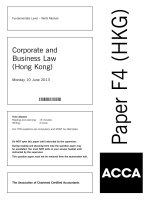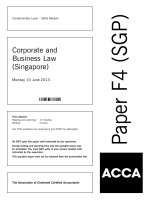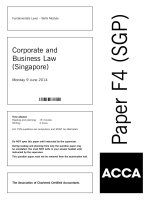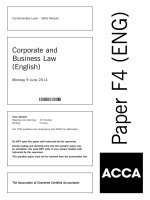ACCA paper f4 corporatre and BUsiness law
Bạn đang xem bản rút gọn của tài liệu. Xem và tải ngay bản đầy đủ của tài liệu tại đây (403.8 KB, 18 trang )
ACCA
Paper F4 eng
Corporate and business law
Pocket notes
Corporate and business law
British library
cataloguing-in-publication
data
A catalogue record for this book is available
from the British Library.
Published by:
Kaplan Publishing UK
Unit 2 The Business Centre
Molly Millars Lane
Wokingham
Berkshire
RG41 2QZ
ISBN 978-1-78415-240-6
© Kaplan Financial Limited, 2015
Printed and bound in Great Britain.
ii
The text in this material and any others
made available by any Kaplan Group
company does not amount to advice on a
particular matter and should not be taken
as such. No reliance should be placed on
the content as the basis for any investment
or other decision or in connection with any
advice given to third parties. Please consult
your appropriate professional adviser as
necessary. Kaplan Publishing Limited and
all other Kaplan group companies expressly
disclaim all liability to any person in respect
of any losses or other claims, whether
direct, indirect, incidental, consequential or
otherwise arising in relation to the use of
such materials.
All rights reserved. No part of this publication
may be reproduced, stored in a retrieval
system, or transmitted, in any form or
by any means, electronic, mechanical,
photocopying, recording or otherwise,
without the prior written permission of
Kaplan Publishing.
kaplan publishing
paper F4 (ENG)
Contents
Chapter 1: Essential elements of the legal system ........................................................................ 1
Chapter 2: Contract law .................................................................................................................13
Chapter 3: Tort .............................................................................................................................. 29
Chapter 4: Employment law ..........................................................................................................37
Chapter 5: Agency law ..................................................................................................................47
Chapter 6: Types of business organisation ................................................................................... 51
Chapter 7: Corporations and legal personality .............................................................................. 57
Chapter 8: Capital and financing ...................................................................................................77
Chapter 9: Directors ......................................................................................................................91
Chapter 10: Corporate administration ........................................................................................... 101
Chapter 11: Insolvency ..................................................................................................................111
Chapter 12: Fraudulent behaviour ................................................................................................. 119
Index
kaplan publishing
......................................................................................................................................I.1
iii
Corporate and business law
Paper background
The aim of ACCA Paper F4 (ENG),
Corporate and Business Law, is to develop
knowledge and skills in the understanding of
the general legal framework, and of specific
legal areas relating to business, recognising
the need to seek further specialist legal
advice where necessary.
Objectives of the syllabus
•
•
Recognise and apply the appropriate
legal rules relating to the law of
obligations.
•
Explain and apply the law relating to
employment relationships.
•
Distinguish between alternative
forms and constitutions of business
organisations.
•
iv
Identify the essential elements of the
legal system including the main sources
of law.
Recognise and compare types of capital
and the financing of companies.
•
Describe and explain how companies are
managed, administered and regulated.
•
Recognise the legal implications relating
to insolvency law.
•
Demonstrate an understanding of
corporate and fraudulent behaviour.
Core areas of the syllabus
•
Essential elements of the legal system.
•
The law of obligations.
•
Employment law.
•
The formation and constitution of
business organisations.
•
Capital and the financing of companies.
•
Management, administration and
regulation of companies.
•
Legal implications relating to insolvency
law.
•
Corporate fraudulent and criminal
behaviour.
kaplan publishing
paper F4 (ENG)
Examination Format
The examination is a two-hour assessment
– available as either a paper-based
examination or as a computer-based
examination.
Divide the time you spend on questions
in proportion to the marks on offer. One
suggestion for this exam is to allocate 2
minutes to each mark available.
Section A:
Multiple-choice questions: Read the
questions carefully. If you don’t know the
answer, eliminate those options you know
are incorrect and see if the answer becomes
more obvious. Guess your final answer
rather than leave it blank if necessary.
•
20 × 1 mark objective test questions
Computer-based examination (CBE) tips
•
25 x 2 mark objective test questions
The assessment will contain 100%
compulsory questions and will comprise the
following:
Section B:
•
5 × 6 mark multi-task questions
Paper based examination tips
Spend the first few minutes of the
examination reading the paper.
Be sure you understand how to use the
software before you start the exam. If in
doubt, ask the assessment centre staff to
explain it to you.
Questions are displayed on the screen and
answers are entered using keyboard and
mouse. At the end of the exam, you are
given a certificate showing the result you
have achieved.
Read each question very carefully.
kaplan publishing
v
Corporate and business law
Double-check your answer before committing
yourself to it.
Answer every question – If you do not know
the answer, you don’t lose anything by
guessing. Think carefully before you guess.
With a multiple-choice question, eliminate
first those answers that you know are wrong.
Then choose the most appropriate answer
from those that are left.
Quality and accuracy are of the utmost
importance to us so if you spot an error in
any of our products, please send an email
to with full
details, or follow the link to the feedback
form in MyKaplan.
Our Quality Co-ordinator will work with our
technical team to verify the error and take
action to ensure it is corrected in future
editions.
Remember that only one answer to a
multiple-choice question can be right. After
you have eliminated the ones that you know
to be wrong, if you are still unsure, guess.
But only do so after you have doublechecked that you have only eliminated
answers that are definitely wrong.
Don’t panic if you realise you’ve answered
a question incorrectly. Getting one question
wrong will not mean the difference between
passing and failing.
vi
kaplan publishing
1
chapter
Essential elements
of the legal system
In this chapter
•
Definition of law.
•
Types of law.
•
Criminal law v Civil law.
•
The main English civil courts.
•
Other civil courts.
•
The main criminal courts.
•
Sources of law.
•
Judicial precedent.
•
The hierarchy of the courts.
•
Rules of statutory interpretation.
•
Human Rights Act 1998.
1
Essential elements of the legal system
Definition of law
The principles and regulations established
in a community by some authority and
applicable to its people whether in the form
of legislation or of custom and policies
recognised and enforced by judicial decision.
2
Types of law
Public law
Private law
Deals with
matters relating
to whole country
e.g. criminal law,
constitutional law and
administrative law.
Deals with law
enforced between
individuals e.g.
contract and family
law.
kaplan publishing
chapter 1
Criminal law v civil law
Criminal law
Civil law
Criminal law relates to conduct which the
State considers with disapproval and which it
seeks to control.
Purpose the enforcement of particular forms
of behaviour by the State, which acts to
ensure compliance.
In criminal law the case is brought by the
State in the name of the Crown. A criminal
case will be reported as Regina v ..., where
Regina means the latin for ‘queen’.
Burden of proof – on the prosecution.
Standard of proof – guilt must be shown
beyond reasonable doubt.
Object – to regulate society by the threat of
punishment.
Civil law is a form of private law and involves the
relationships between individual citizens.
If found guilty the criminal court will sentence
the defendant and it may fine him or impose
a period of imprisonment. If innocent the
accused will be acquitted.
kaplan publishing
Purpose to settle disputes between individuals
and to provide remedies.
In civil law the case is brought by the claimant,
who is seeking a rememdy. The case will be
referred to by the names of the parties involved
in the dispute, such as Brown v Smith.
Burden of proof – on the claimant.
Standard of proof – liability must be shown on
the balance of probabilities.
Object – usually financial compensation to put
the claimant in the position he would have been
in had the wrong not occurred.
The civil court will order the defendant to pay
damages or it may order some other remedy,
e.g. specific performance or injunction.
3
Essential elements of the legal system
The main English civil courts
Supreme Court (previously House of Lords)
Normally 5 Justices hear appeals from Court of Appeal and exceptionally from High Court
Court of Appeal
3 Lords Justices of Appeal hear appeals from the High Court and County Courts
High Court of Justice
County Court
First instance civil claims in contract, tort,
landlord & tenant, probate and insolvency.
1 District judge hears small claims (max £10,000).
1 Circuit judge hears most fast-track cases (£10,000 £25,000) and some multi-track cases (over £25,000 and/
or complex cases).
1 High Court judge in first instance. 2-3 for appeals.
Queens Bench Division hears first instance contract and
tort multi-track claims. Chancery Division
deals with land law, trusts, company law, partnership
law, insolvency, etc. Hears appeals from County Courts
on probate & insolvency. Family Division
hears matrimonial cases.
Magistrates’ court
Jurisdiction is mainly criminal (see section on criminal courts) but does
have civil jurisdiction in family matters such as contact orders, adoption,
and maintenance. There are also powers of recovery of council tax arrears
and charges for water, gas and electricity.
4
kaplan publishing
chapter 1
Other civil courts
European Court of
Justice
European Court of
Human Rights
Deals with actions
between the EU
institutions and the
member states.
The final court
of appeal in
relation to matters
concerning the
Human Rights Act
1998.
Ultimate authority
on European Law.
It is therefore
superior to the
House of Lords.
Cases are referred
to it by national
courts.
No appeal.
kaplan publishing
Must have
exhausted
proceedings in
the English courts
before ECtHR will
hear case
No appeal.
5
Essential elements of the legal system
The main criminal courts
Supreme Court (previously House of Lords)
Normally five Justices hear appeals from the Court of Appeal
and exceptionally from High Court.
Court of Appeal
Three Lord Justice of Appeal hear appeals from the Crown Court.
Crown Court
Presided over by a judge whose role is to decide questions of law and
impose the punishment.
Case will be heard before a jury whose role is to decide questions of
fact i.e. whether defendant is guilty of the offence.
High Court (Queens Bench Division)
Three judges preside.
Hears appeals from Magistrates
Court on points of law.
Appeals go directly to the
House of Lords.
Magistrates Court
Court of first instance. Deals with criminal cases in various ways:
• Summary offences – decides whether defendant is guilty of the offence and imposes the penalty.
• Indictable offences – where there is to be trial by jury. Magistrates will conduct committal
proceedings to make sure the defendant has a case to answer.
• Offences triable either way – the defendant can choose whether to be tried in the Magistrates
Court or the Crown Court.
Presided over by either:
• Lay Magistrates. The bench usually consists of three.
• Stipendiary Magistrate sitting alone.
• Appeals on questions of fact fo to the Crown Court.
• Appeals on questions of law go to the high Court.
6
kaplan publishing
chapter 1
Sources of law
Case law
Legislation
Common law
Direct legislation = Acts of Parliament.
•
•
•
A Bill must go through the following stages
in both the House of Lords and the House of
Commons: 1st reading, 2nd reading, committee
stage, report stage, 3rd reading, Royal Assent.
Introduced the system of precedent.
The only remedy was damages.
Rigid and inflexible.
Equity
•
•
•
•
Began as a form of appeal.
More flexible than the common law.
Introduced new discretionary remedies
such as injunctions and specific
performance.
Concerned with fairness.
Equitable remedies are not available as of
right. Must meet the maxims of equity: e.g.
•
•
He who seeks equity must have acted
equitably; and
delay defeats equity.
kaplan publishing
Indirect legislation = delegated legislation.
Consists of:
•
Statutory instruments – Made by
Government Ministers using powers
delegated by Parliament
•
Bye-laws – Made by local authorities
•
Orders in Council – Made by the Privy
Council in the name of the Monarch on the
advice of the Prime Minister.
7
Essential elements of the legal system
Judicial precedent
8
Ratio decidendi
Obiter dicta
The legal reason for the decision
Statements which are not part of the ratio
The ratio is capable of forming the
binding precedent
Persuasive rather than binding precedent
kaplan publishing
chapter 1
The hierarchy of the courts
Supreme Court – Binds all lower courts.
From 1966 does not bind itself.
Court of Appeal – Binds all lower courts and itself unless earlier
decision overruled or inconsistent with European law.
Not bound by own criminal decisions.
High Court – Not bound by its own decisions,
but strong persuasive authority.
Advantages of judicial precedent – consistency, flexibility, practical.
Disadvantages – complex, restricts judges’ discretion. However, judges retain discretion by
‘distinguishing on the facts’ or overruling lower courts.
kaplan publishing
9
Essential elements of the legal system
Rules of statutory interpretation
Literal rule
Golden rule
Words must be
given their ordinary
grammatical meaning,
even if it produces an
undesirable outcome.
Used where the literal
rule gives more than one
meaning or provides an
absurd result.
Fisher v Bell – It was
a criminal offence to
‘offer for sale’ a flickknife. A shopkeeper
who displayed one in
his shop window was
held not guilty as the
court chose to follow the
contract law meaning of
the word ‘offer’.
Adler v George – The
words ‘in the vicinity of’
a prohibited place’ in the
Official Secrets Act were
held to cover the acts of
the defendant which took
place ‘within’ a prohibited
place.
Involves choosing the
meaning that produces
the least absurd result.
Mischief rule
Purposive Rule
Used to interpret
a statute in a way
which provides
a remedy for the
mischief the statute
was enacted to
prevent.
The purpose of an Act
was to provide for the
safe storage of film
wherever it might be
stored on ‘premises’.
The claimant argued
that ‘premises’ did not
include a cave and
so the Act had no
application to this case.
Gorris v Scott –
As the purpose of
the statute was to
prevent the spread of
contagious disease
and not guard
against the danger
of the property being
washed overboard,
the claim failed.
Gardiner v Sevenoaks
RDC (1950) – The
purpose of the Act was
to protect the safety of
persons working in all
places where film was
stored. If film was stored
in a cave, the word
‘premises’ included the
cave.
Note also – Euisdem generis – general words mean the same kind of thing as the specific words
they follow. Expressio unio est exclusio alterius – a statute which expresses particular things by
implication excludes everything else.
10
kaplan publishing
chapter 1
Human Rights Act 1998
What is its purpose?
The HRA 1998 incorporates the European Convention for the Protection
of Human Rights and Fundamental Freedoms into UK domestic law.
What is convention
law?
Convention law = the Convention + decisions of the European Court of
Human Rights.
How does it
affect judicial
interpretation?
UK courts must take Convention law into account when deciding a
question which has arisen in connection with a Convention right.
Any impact on
the doctrine of
precedent?
Judges will not be bound by a previous interpretation of existing
legislation where it did not take into account Convention rights –
Mendoza v Ghaidan (2003).
What if legislation
is incompatible with
the Convention?
The courts cannot declare primary legislation invalid. They can only
make a declaration of incompatibility and leave it to Parliament to remedy
the situation through new legislation. However, the courts do have
the power to declare secondary legislation (e.g. statutory instruments)
invalid.
What is derogation?
A derogation is a provision which allows for all or part of a legal measure
to be applied differently, or not at all.
kaplan publishing
11
Essential elements of the legal system
12
kaplan publishing









